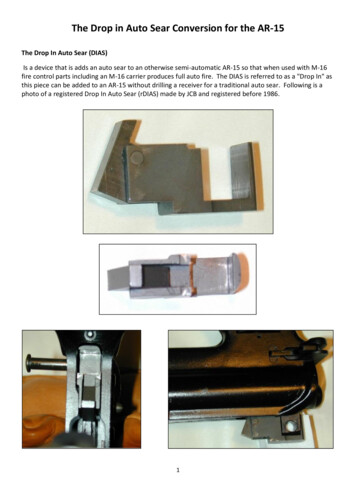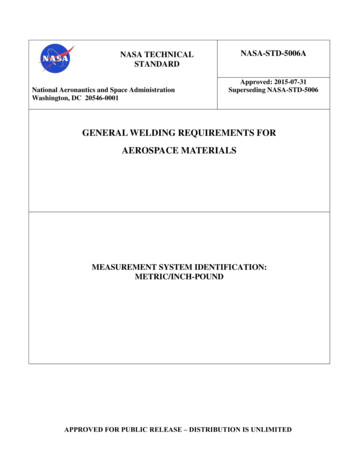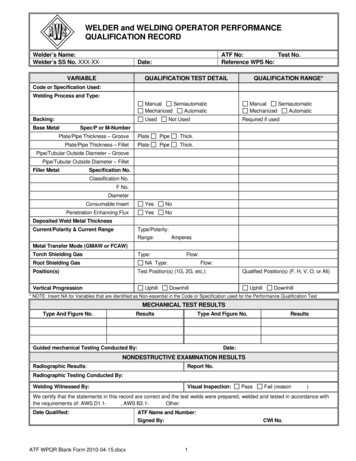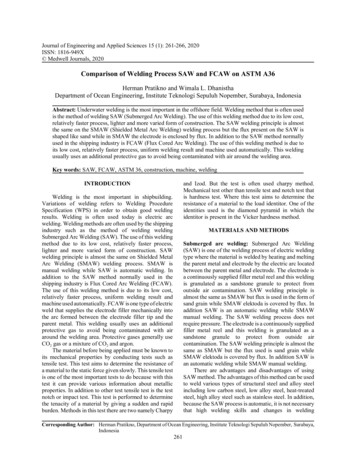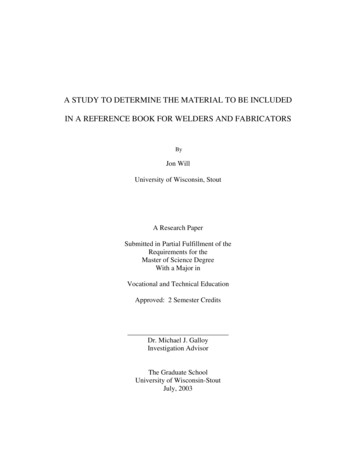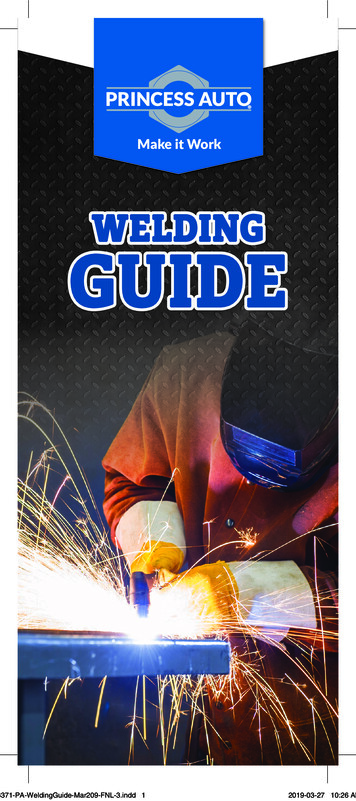
Transcription
Make it indd 12019-03-27 10:26 AM
CONTENTSThe Welding Process . . . . . . . . . . . . . . . . . . . . . . . . . . . . . . . . . . . . . . . . . . . . . . . . . . . . . . . . . . . . . . . 1What to Look for When Choosing a Welder . . . . . . . . . . . . . . . . . . . .1Common Welding Processes . . . . . . . . . . . . . . . . . . . . . . . . . . . . . . . . . . . . . . . . . . . . . . . . 2Shielded Metal Arc Welding (SMAW) – Stick . . . . . . . . . . . . . . . . . 2Gas Metal Arc Welding (GMAW) – MIG . . . . . . . . . . . . . . . . . . . . . . . . . . . 3Flux-Cored Arc Welding (FCAW) – Gasless . . . . . . . . . . . . . . . . . . . . . 4Gas Tungsten Arc Welding (GTAW) – TIG . . . . . . . . . . . . . . . . . . . . . . . . 5Multi-Process Welders . . . . . . . . . . . . . . . . . . . . . . . . . . . . . . . . . . . . . . . . . . . . . . . . . . . . . . . . . . . 6Inverter Welders . . . . . . . . . . . . . . . . . . . . . . . . . . . . . . . . . . . . . . . . . . . . . . . . . . . . . . . . . . . . . . . . . . . . . . 6Plasma Cutting . . . . . . . . . . . . . . . . . . . . . . . . . . . . . . . . . . . . . . . . . . . . . . . . . . . . . . . . . . . . . . . . . . . . . . . . . . .7Resistance Spot Welding (RSW) . . . . . . . . . . . . . . . . . . . . . . . . . . . . . . . . . . . . . . . . . .8Oxy-Acetylene . . . . . . . . . . . . . . . . . . . . . . . . . . . . . . . . . . . . . . . . . . . . . . . . . . . . . . . . . . . . . . . . . . . . . . . . . . 8Application Charts . . . . . . . . . . . . . . . . . . . . . . . . . . . . . . . . . . . . . . . . . . . . . . . . . . . . . . . . . . . . . . . . . . . 9Glossary of Welding Terms . . . . . . . . . . . . . . . . . . . . . . . . . . . . . . . . . . . . . . . . . . . . . . . . . 123371-PA-WeldingGuide-Mar209-FNL-3.indd 22019-03-27 10:26 AM
WELDING BUYER’S GUIDEWelcome to the Princess Auto Welding Buyer’s Guide!Our goal is to help you make the right choice for your weldingneeds. This convenient guide will give you all the informationyou require to select the right welder for your project. Havinga welder in your tool arsenal can greatly assist you in yourbuilding and maintenance needs.We carry a wide selection of welders for every skill level - allat affordable prices, and backed by our Royal Service guarantee.Our comprehensive assortment of accessories will keep yousafe, and help get the job done right!THE WELDING PROCESSWelding is a process for joining or fastening two pieces of similarmetals (workpieces) by melting and fusing 1) the base metals beingjoined and 2) the filler metal applied. Workpieces are weldedtogether by applying extreme heat, resulting in melting bothpieces and the filler metal (rod/wire) to a molten state that coolsto form a strong joint. The energy to form the joint between metalworkpieces most often comes from a flame (e.g. oxy-acetylene)or an electric arc. Most welding involves ferrous-based metalssuch as steel and stainless steel. Welding covers a temperaturerange of 815 to 1,649 C (1,500 to 3,000 F), and is the strongestmethod for bonding metal to metal. Welding can also be donewithout the use of a filler metal, by using heat energy alone.WHAT TO LOOK FOR WHEN CHOOSING A WELDERTypical Applications:Consider the most common uses and applications for yourwelder: construction, farm/ranch, general maintenance/repair,home, autobody repair, etc. Welders are designed for certainapplications, depending on rated output, duty cycle and otherfeatures. For example, aluminum repairs require either a heavyduty MIG welder with a spool gun, or a TIG welder that canhandle different types and sizes (thickness) of metal. Repairinga wrought iron railing can be done using just a stick welder.When choosing an electric welder,consider the important factors:What power is available?Do you have 230V power in your garage or workshop? If not, youwill have to limit yourself to a 115V welder. If electrical hook-up isnot available, a gas-powered welding generator can supply weldingand auxiliary power.How thick is your base metal?The thicker the material, the more powerful the welding machineyou will need. See the chart guidelines (pages 9-10).3371-PA-WeldingGuide-Mar209-FNL-3.indd 112019-03-27 10:26 AM
How much will you use your welder?If you plan to use your welder for long sessions, you should chooseone with a high duty cycle. This will allow you to weld for longerperiods before the machine needs to stop and cool down. Dutycycle is a rating that indicates how many minutes, out of ten, that awelder can produce its maximum output without overheating.What materials will you be welding?Remember that flux-core wire and most small rods for 115V stickwelders only work on mild steel. If you plan on welding aluminumor stainless steel, you must buy a mIG or 230V arc (stick) welder.230V arc welders can also weld with other specialty rods such ascast iron, hard facing, cutting, and machinable rods.COMMON WELDING PROCESSESSHIELDED METAL ARC WELDING (SMAW) – STICKWelding skill level: moderateThis process uses a consumable electrode to support the arc.Shielding is achieved by the melting of the outer flux coating onthe electrode. Filler metal is obtained from the elctrode core. Good for windy, outdoor conditions OK to use on dirty or rusty metalRecommended metal: Steel, stainless steel, cast ironStandard Arc Welding Rods E6011 - easy to use all-purpose rod with good penetration,even with dirty base metal - mild and medium carbon steels E6013 - general purpose all-position rod with low spatterproduces a better, cleaner weld E7014 - all-position rod with a high deposition rate for fasterwelding E7018 - low hydrogen rod produces tough, high strength weldsRequired Equipment: Welding helmets Leather gloves/protective clothing Electrodes: rods23371-PA-WeldingGuide-Mar209-FNL-3.indd 22019-03-27 10:26 AM
GAS METAL ARC WELDING (GMAW) – MIGWelding skill level: low to moderateA process used with a wire-fed welding machine. Metals are joinedby heating them with an arc, which is between the continuouslyfed filler metal electrode (solid wire) and the workpiece. Externallysupplied gas or gas mixture provide shielding. Easy process to learn Better control on thinner metals Cleaner welds with less slag to clean Equipment can be used for flux-cored weldingRecommended metal: Steel, stainless steel, aluminum, cast ironMIG WireMIG wire requires different shielding gases depending on thetype of wire being used. Most MIG wires are available in 0.024 in.,0.030 in. and 0.035 in. diameters. E70S - mild steel MIG Wire - 75% Argon, 25% CO2 E316 - stainless steel MIG Wire - 75% Argon, 25% CO2 E4043 - aluminum MIG Wire - 100% ArgonRequired Equipment: Welding helmet Leather gloves Electrodes: rods, flux-cored wire or MIG wire Gas hose Gas regulator MIG shielding gas3371-PA-WeldingGuide-Mar209-FNL-3.indd 332019-03-27 10:26 AM
FLUX-CORED ARC WELDING (FCAW) – GASLESSWelding skill level: lowA process that uses a wire-fed welding machine. Metals are meltedand joined by heating them with an arc between a continuous,consumable electrode wire and the workpiece. The weld is tubularwith flux material contained inside the shielding. Added shieldingmay or may not be supplied from external gas or gas mixture,depending on the type of flux-cored wire being used. Works well on dirty or rusty material Deep penetration for welding thick sections Can be used with or without shielding gas Self-shielded wire is best for outdoors and windy conditions Flux-cored wire produces shielding gas when the flux inside thewire meltsRecommended metal: Steel, stainless steelStandard Flux Core Wire E71T- flux-cored wire is available in 0.030 and 0.035 diametersRequired Equipment: Welding helmet Leather gloves/protective clothing Electrodes: flux-cored wire43371-PA-WeldingGuide-Mar209-FNL-3.indd 42019-03-27 10:26 AM
GAS TUNGSTEN ARC WELDING (GTAW) – TIGWelding skill level: highThis process uses welding equipment with a high-frequencygenerator. The arc is created between a non-consumable tungstenelectrode and the workpiece. Filler metal may or may not be used,and argon inert gas or intert gas mixtures are used for shielding. Provides high-quality, precise welds Highly aesthetic weld beadsRecommended metal: (AC TIG): Aluminum, magnesium alloys, (DC TIG): Steel, stainlesssteel, copper, brass, and titanium Standard TIG welding rods EWTh-2 - All-purpose rod for welding steel and stainless steel EWCe-2 - General-purpose rod for low amperage weldingRequired Equipment: Welding helmet Leather gloves/protective clothing Electrodes: TIG rods, tungsten rods Gas hose Gas regulator TIG gas (typically pure argon or an argon mix) shielding gas Optional foot pedal3371-PA-WeldingGuide-Mar209-FNL-3.indd 552019-03-27 10:26 AM
MULTI-PROCESS WELDERSA welder that does more than one process. Some do TIG, stick,and MIG, while others do TIG and stick. Multi-process weldersoffer you the most bang for your buck and they don’t compromiseon power. Ideal for the hobbyist, do-it-yourselfer, or smallcontractor who wants to do MIG welding and more, includingstick, TIG and flux-cored welding. An efficient and easy way tohave all common welding processes in one compact unit. Greatfor all skill levels as the machines are extremely user frienclyand can do the whole range from simple to advanced welds.INVERTER WELDERSAll Pro.Point welders are inverter weldersTraditional welders use electrical transformers to distributethe current, but inverter welders use computerized circuit boardtechnology to efficiently amplify and distribute input energy toproduce the desired welding current. The input is AC current,but the output is DC current to achieve a better weld. Invertertechnology allows for lighter, smaller machines, with more powerand better efficiency. A superior technology that is typically slightlymore costly than a traditional welder, but well worththe investment.63371-PA-WeldingGuide-Mar209-FNL-3.indd 62019-03-27 10:26 AM
PLASMA CUTTINGWelding skill level: lowPlasma cutters are ideal for cutting and fabricating metal –from thin sheets, to thick beams. Plasma cutting employs a torch,which uses a powerful electric arc to create plasma, made byboosting a gas (nitrogen, argon or oxygen) to a very hightemperature. This creates a stream, or cone, of directed plasmathat can reach a temperature of 16,650 C (30,000 F). Handheldtorches can usually cut up to 1/2 in. (13 mm) thick steel plate,and stronger computer-controlled torches can pierce and cutsteel up to 12 in. (300 mm) thick. Unlike laser cutting, forexample, the process of plasma cutting is only effective onmaterials that conduct electricity.Recommended metal: Any conductive metal - mild steel, aluminum and stainlesssteel are some examples With mild steel, operators will experience faster, thickercuts than with alloysRequired Equipment: Welding helmet or welding goggles Leather gloves/protective clothing Air compressor3371-PA-WeldingGuide-Mar209-FNL-3.indd 772019-03-27 10:26 AM
RESISTANCE SPOT WELDING (RSW)Welding skill level: lowTwo separate pieces of metal are joined by passing acurrent between electrodes positioned on opposite sidesof the workpieces. No arc is used; rather, it is the resistanceof the metal to the current flow that fuses the pieces. Portable and easy to operate Ideal for light industrial applicationsRecommended metal: Steel, stainless steelRequired Equipment: Welding helmet or welding goggles Leather gloves/protective clothingOXY-ACETYLENESkill level: low to moderateTorch OutfitsOxy-acetylene torch outfits use oxygen and acetylene gas tocreate a portable heat source. They can be used for welding,brazing and cutting.Welding and BrazingWelding or brazing rods are melted by the oxy-acetylene torchto create strong metal bonds. One advantage of brazing is thata wide variety of metals can be joined with theis process including:brass, copper, bronze, aluminum and chrome-plated metal.Also, brazing can be done at a lower temperature than welding,which reduces the risk of warping the base metal.83371-PA-WeldingGuide-Mar209-FNL-3.indd 82019-03-27 10:26 AM
CuttingTorch cutting is very useful, especially when cutting elaborateshapes not suitable for cutting with a band saw. Only metals that canrust, or be oxidized (typically steel) can be cut with a cutting torch.Required Equipment: Goggles (shade # 5 lens) Leather gloves Oxygen gas tank Acetylene gas tank Oxygen and acetylene gas regulators Double line hoseBrazing and welding only Brazing or welding rods Brazing flux (for uncoated rods)APPLICATION CHARTSARC WELDING ELECTRODE USAGE 010DC --AllHighMinimumpreparationwith rough,high spatterE6011DC YesAllHighE6013DC ,DC-YesAllLowE7014DC ,DC-YesAllMediumE7018,E7018ACDC YesAllLowLow hydrogen,strong weld,low spatterLow alloy steelE308LDC YesAllHighIncreasedcorrosionresistanceStainless steelE4043DC --AllHighDecreased weldcrackingAluminumE312-16DC YesAllMediumGeneralpurpose, lowspatterMetalsMild steel withmoderate surfacecontaminants,galvanized steelSheet metal (mildsteel), galvanizedsteelSheet metal(mild steel)Smooth, greatSheet metal andfor beginners,fillet weldslow spatterUniversalAll steels, or forelectrode, crackjoining dissimilarresistant, strongsteelsweld* DC electrode positive (Reverse Polarity);DC- electrode negative (straight polarity)3371-PA-WeldingGuide-Mar209-FNL-3.indd 992019-03-27 10:26 AM
ARC WELDING AMP RANGE CHARTElectrode (rod)Diameters (inches)1/163/321/85/32E6010--40 - 8575 - 125110 - 165E601120 - 3040 - 8575 - 125110 - 165E601320 - 4540 - 9080 - 130105 - 180E701435 - 6080 - 125110 - 165150 - 210E701830 - 5065 - 100110 - 165150 - 220E7018 AC30 - 5065 - 100110 - 165150 - 220E308L--40 - 70----E4043----70 - 120--E312-16--50 - 8080 - 120100 - 160103371-PA-WeldingGuide-Mar209-FNL-3.indd 102019-03-27 10:26 AM
MIG WELDING WIRE THICKNESS CHARTSolid MIG Wire (in.)MaterialThickness.024.030.035Flux-Core Wire (in.).045.030.035.04524 gauge(.025 in.)22 gauge(.031 in.)20 gauge(.037 in.)18 gauge(.050 in.)16 gauge(.063 in.)14 gauge(.078 in.)1/8 in.(.125 in.)3/16 in.(.188 in.)1/4 in.(.25 in.)5/16 in.(.313 in.)3/8 in.(.375 in.)TIG WELDING TUNGSTEN ELECTRODE USAGEType ofTungstenPureUses and PerformancesGood arc stability for AC welding. Reasonablegood resistance to contamination, Lowestcurrent carrying capacity. Maintains balled end.Thoriated(Th021)1.7% - 2.2%Easy arc starting. High current capacity.Greater arc stability. High resistance to weld poolcontamination. Difficult to maintain balledend on AC.Ceriated (Ce02)1.8% - 2.2%Similar performance to thoriated tungsten.Easy arc starting, good arc stability and long life.Possible substitute for thoriated.Lanthanated(La203)1.3% - 1.7%Zirconiated(Zr02)0.15% - 0.40%Similar performance to thoriated tungsten. Easyarc starting, good arc stability and long life. Highcurrent capacity. Possible substitute for thoriated.Excellent for AC welding due to favourableretention of balled end. High resistance tocontamination, and good arc starting. Preferredwhen tungsten contamination is intolerable.3371-PA-WeldingGuide-Mar209-FNL-3.indd 11112019-03-27 10:26 AM
METAL TYPE PROCESS CHARTMetal TypeARC (stick)MIG/FluxSteelXStainlessXAluminumCast IronAC-TIGDC-TIGPlasmaXXXXXXXXXXCopper, BrassXXTitaniumXXXXXMagnesiumAlloysSkill levelXModerateLowHighHighLowGLOSSARY OF WELDING TERMSArc [Arc Length] - The physical gap between the end of theelectrode, and the point where the arc makes contact withthe base metal.Brazing - A group of welding processes in which a groove,fillet, lap, or flange joint is bonded by using a non-ferrous fillermetal having a melting point above 427 C (800 F), but belowthat of the base metals. Filler metal is distributed in the jointby capillary attraction.Braze Welding - A method of welding by using a filler metal thatliquefies above 450 C (842 F) and below the solid state of thebase metals. Unlike brazing, the filler metal in braze welding is notdistributed in the joint by capillary action.Butt Welds - A welding technique where two pieces of metalare joined in the same plane.Chamfer - A transitional edge, usually at a 45 angle.Also known as a bevel.Duty Cycle - The time per weld out of a 1-minute periodthat an arc welder can be operated at maximum rated output.For example, a 60% duty cycle @ 300A means that the weldingmachine can weld for 36 seconds (at 300A) and then must beallowed to cool with the fan running for 24 seconds. Thisreduces the chance of heat damage to the system.Electrode - A coated metal wire having the same compositionas the material being welded. It can be of stick or wire spool type.Electric Arc - Electrical conduction that occurs when a strongcurrent jumps a gap in a circuit.Fillet Weld - Joins two surfaces at an approximate right angleto each other. There are several types of fillet weld.123371-PA-WeldingGuide-Mar209-FNL-3.indd 122019-03-27 10:26 AM
Filler Metal - A metal added in the making of a joint throughwelding, brazing, or soldering. Four types of filler metals exist–covered electrodes, bare electrode wire or rod, tubularelectrode wire, and welding fluxes.Flux - The coating on arc welding rods and in flux-cored weldingwire that is consumed in the arc to produce a shielding gas.The gas displaces air and impurities from around the weld.Groove Weld - A weld between the existing preformed groovesin pieces being joined.Ground Lead / Workpiece Lead - The conductor cable or electricalconductor between the arc welding machine and the work.Non-Ferrous Metals - Any metal, including alloys, that does notcontain iron in appreciable amounts. Generally more expensivethan ferrous metals.Polarity - Polarity is the direction electric current flow.With straight (DC-) polarity, heat is greater at the workpiece,which increases penetration. With reverse polarity (DC ) heatis greater at the electrode, which provides a steadier arc. Reversepolarity is better for making out-of-position welds.Rated Output - The amperage and voltage the power sourcewill produce for a given duty cycle period. For example, 300A,32 load volts @ 60% duty cycle.Shielded Gas - Protective gas used to prevent atmosphericcontamination of the weld pool. Usually a mixed gas or C02.Slag - A layer of flux soot protecting the weld from oxidesand other contaminants while the weld is solidifying (cooling).Slag is to be removed after cooling.Spatter - Metal particles thrown from the weld. often coolingand hardening on the work surface. A spatter-resistant sprayapplied to the workpiece can minimize spatter.Torch - A device in the TIG process to control the position ofthe electrode, to transfer urrent to the arc and to direct theflow of shielding gas.Tungsten - A rare metallic element with extremely high meltingpoint used for manufacturing TIG electrodes.Welding Position - All welding can be classified according to theposition of the workpiece, or the position of the welded joint onthe plates or sections being welded. Some welding processes haveall-position capabilities, while others may be used in only one ortwo positions. The 4 basic weld positions are: flat, horizontal,vertical, and overhead.Wire Feed - Motor driven deck which feeds welding wire throughthe welding nozzle.Wire Feed Speed - Expressed as in./min. or mm/sec, and refersto the speed and amount of filler metal fed into a weld. The higherthe wire feed speed, the higher the amperage.3371-PA-WeldingGuide-Mar209-FNL-3.indd 13132019-03-27 10:26 AM
Visit princessauto.comto see our full line ofwelding equipment, plasmacutters, and accessories.3371-PA-WeldingGuide-Mar209-FNL-3.indd 142019-03-27 10:26 AM
WELDING GUIDE 13371-PA-WeldingGuide-Mar209-FNL-3.indd 1 2019-03-27 10:26 AM . STICK Welding skill level: moderate This process uses a consumable electrode to support the arc. Shielding is achieved by the melting of the outer flux coating on the electrode. Filler metal is obtained fro


